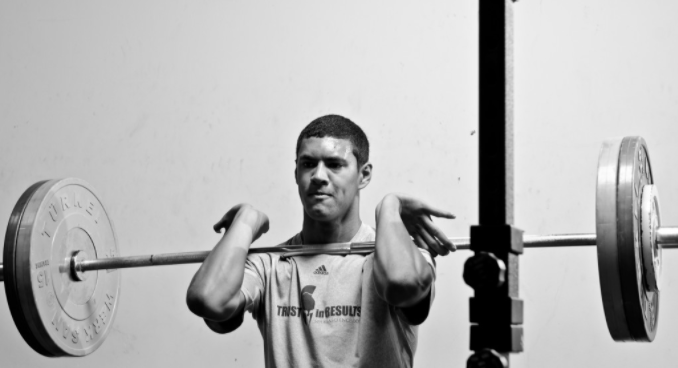
One of our key metrics that we use to evaluate the movements that we choose at Sparta is scalability. Scalability means that the movement can be made infinitely harder or easier by adding or subtracting weight. In addition to scalable, the metrics of objective (set range of motion) and universal (can be performed anywhere) have forced us to scrutinize the movements that we do and the way that we do them.
We perform the rear foot elevated split squat with our athletes who need DRIVE on their Movement Signature. Part of the success of this prescription is our ability to make the loading scheme for this movement scaleable and universal. Many coaches and athletes split squat by holding dumbells as their primary method of loading. We have found that using the front squat grip or the front rack position is more effective because it allows for heavier loading and it reinforces better trunk position.
We also favor the front rack position to a back loaded position because the split squat is a very difficult movement to spot. If an athlete gets in trouble or loses balance in the bottom of their split squat they can always just dump the front rack position on the ground. With a back loaded position the athlete would be in greater danger. Additionally, the front rack position reinforces the forward lean that we are looking for through the torso while the back loaded position encourages over extension of the lumbar spine.
The front rack is a challenging position for many athletes to get into, and as a result many immediately opt for a crossover style front squat grip instead. While there are some athletes that do have legitimate structural restrictions to their mobility, most just need some better coaching and practice in order to improve their front rack position.
The front rack position requires the shoulder to be in external rotation while the crossover grip requires internal rotation. This external rotation of the shoulder helps to improve extension of the thoracic spine, while internal rotation can lead to flexion of the thoracic spine. Athletes who allow the thoracic spine to collapse often end up trying to overuse the lumbar errectors to create extension and maintain their spinal position. When handling heavy loads in the split squat, the ability to maintain proper spinal position is important for safe and effective movement, and loss of thoracic position can often lead to lower back pain.
Relax the fingers and let the bar rest on the “meaty” part of the shoulder
Keep the elbows up in order to create a shelf that is always parralel to the ground
Drive the elbows together in order to create extra external rotation at the shoulder which will help maintain thoracic extension
The front rack position can be awkward for some athletes to learn initially, and it can be uncomfortable for those with mobility restrictions. These simple cues can go a long way toward improving the front rack, but there will be some who need additional mobility work around the shoulder, elbow, and wrist in order to get into position. As a coach you must evaluate the cost and benefit for each athlete in regards to working on the front rack or opting for the crossover grip. In the long run the front rack position provides great benefits for shoulder position and postural strength, and the best way to get better is to practice. So, load up a bar and get to work on improving your front rack position.